
This page (Page #8)
has creative activities for use in the classroom. Kids love to
learn more about the play’s origin and subject. Check out
these articles and activities related to ArtReach’s popular titles: Amelia
Earhart, Winnie-the-Pooh, A
Christmas Wizard of Oz, Pinocchio, Emperor's
New Clothes, Robin
Hood, Sleepy Hollow, Christmas
Peter Pan, Kid Frankenstein, Little
Mermaid, Jack and the Beanstalk, The
Jungle Book, A Thousand Cranes. Don’t
forget, a Teachers Guide will come with your School Play Package and
contains tons of creative new ideas for your teaching lessons!

ArtReach's
Amelia Earhart for 5th
Graders - The Rev Theatre Company Study Guide
PLAY
SYNOPSIS & CHARACTER
SUMMARY
The
play begins in the present day with a reporter explaining his
fascination with discovering who Amelia Earhart really was and the
truth of what happened to her.
Time
shifts back to 1928 and we are inundated with sights and sounds of
the roaring 1920's. We meet George Palmer Putnam (G.P.)-a publisher,
author and explorer. G.P. has asked Amelia to meet him in his office
and tells her he is looking for a female pilot to fly across the
Atlantic. Amelia is reluctant at first, but then agrees.
"Fascination
with discovering who Amelia Earhart really was."
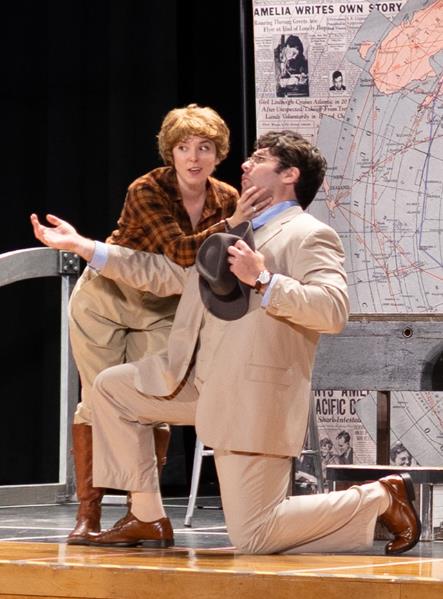
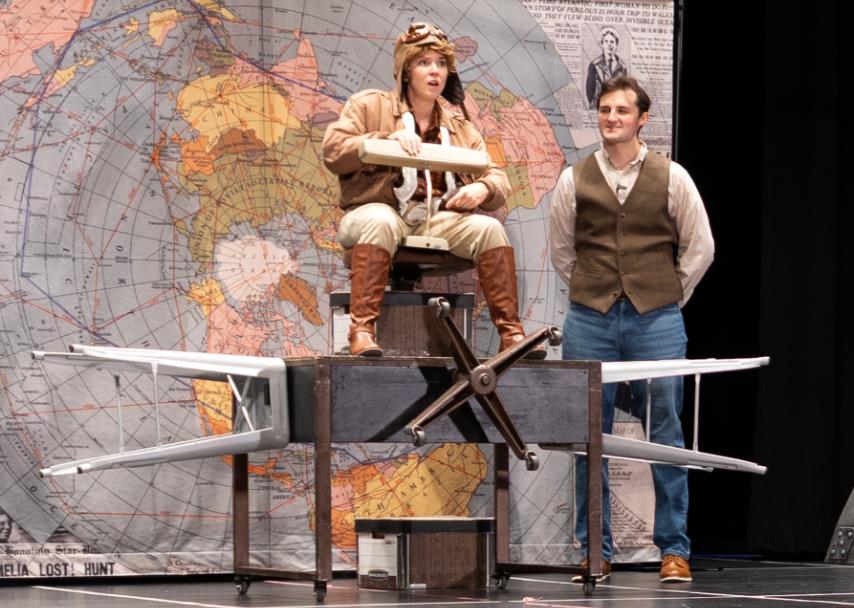
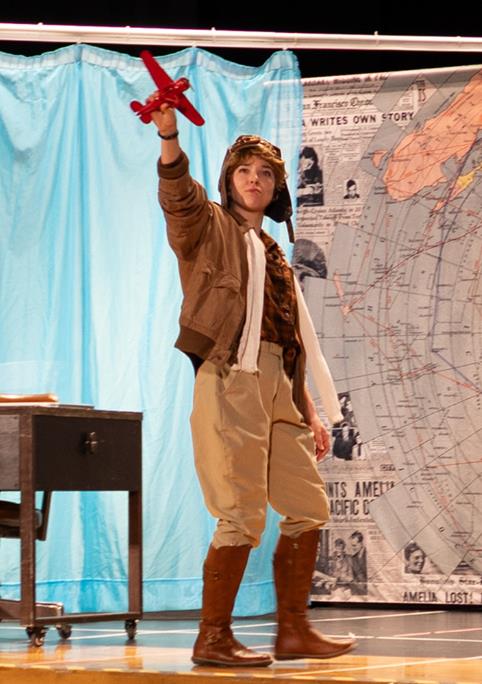
ArtReach's Amelia
Earhart - Scenes from The Rev Theatre Company Performance,
Auburn NY.
Time
shifts to the day of the flight. We learn there were two men on the
plane with Amelia. Bill Schultz, the pilot, and Slim Gordon the
Mechanic. Amelia was simply a passenger, writing in her diary.
Through action on stage, we see the plane hit turbulence due to dense
fog and make a sudden landing in Wales. Although it was not the
original destination, the flight is deemed a success since they
indeed crossed the Atlantic. Amelia becomes instantly famous, but
struggles with the fact that she was simply a passenger.
G.P.
and Amelia's relationship grows. G.P. repeatedly proposes marriage
to Amelia, and on the 6th time, she finally agrees.
"We
see the plane hit turbulence due to dense fog."

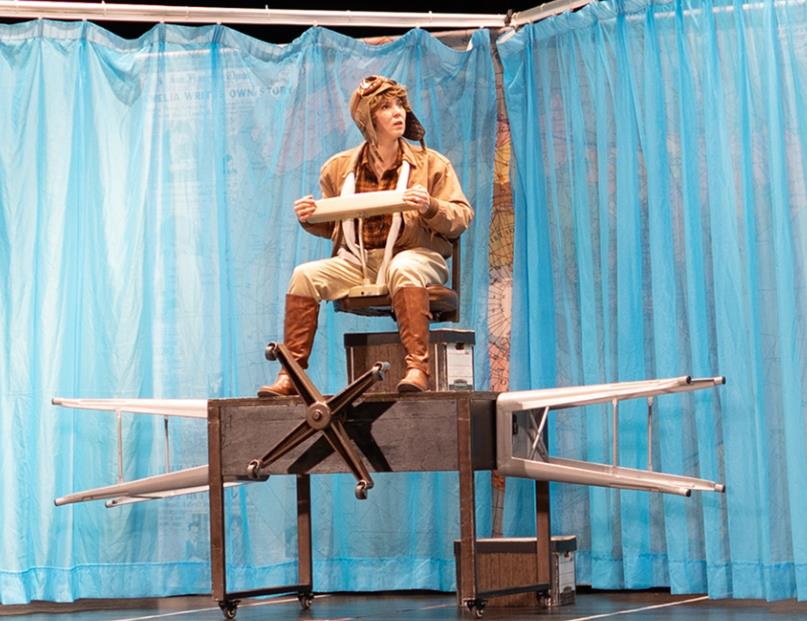
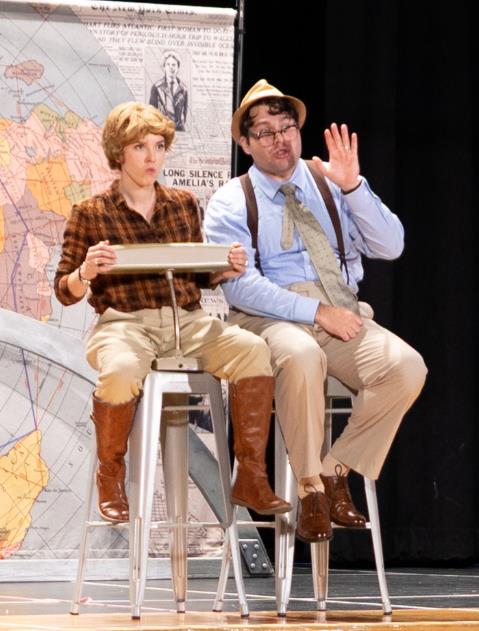
ArtReach's Amelia
Earhart - Scenes from The Rev Theatre Company Performance,
Auburn NY.
The
play continues with Amelia telling G.P. that she wants to fly the
Atlantic again, but this time solo. G.P. agrees, and Amelia takes
flight. Unfortunately, she has a system failure and must make an
emergency landing in a cow pasture in Ireland. She's done it! Amelia
is showered with accolades for being the first woman to fly solo
across the Atlantic.
Throughout
the play, the political, societal and economic times of the country
are underscoring and impacting Amelia and G.P.'s life. Nevertheless,
Amelia decides to attempt the greatest feat of an aviator to date- a
solo flight around the world. She promises G.P. that this will be her
final flight.
Emilia
raises the money needed to purchase a new airplane, and learns to
fly it with a former Hollywood stuntman named Paul Mantz.
It
is now 1937 and Amelia sets off on her flight around the world. The
first leg goes smoothly, however her takeoff from Hawaii does not.
The plane crashes during takeoff and must be repaired before she can
continue. The repairs are completed; however we learn that Amelia
removes a critical radio antenna from the plane. She begins the trek
again-this time flying West to East.
"Amelia
decides to attempt the greatest feat of an aviator to date."

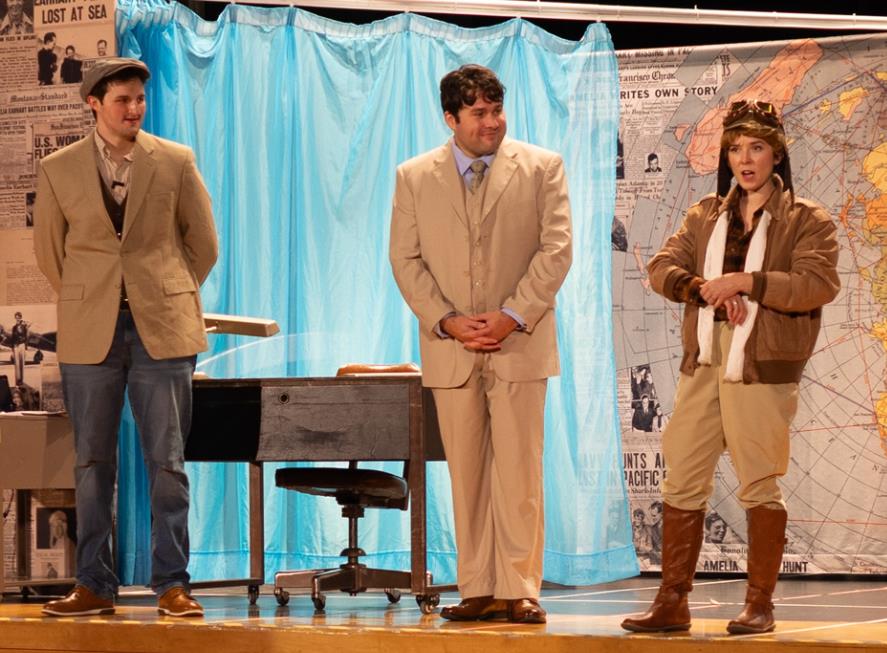
ArtReach's Amelia
Earhart - Scenes from The Rev Theatre Company Performance,
Auburn NY.
The
play continues with what is known about the final hours of Amelia's
life. Radio control struggles to communicate with Amelia, and
eventually loses communication all together. We hear Amelia's famous
last words: Fuel is running low. We are running north and south.
The
play concludes with the reporter grappling with his own emotions
surrounding the mystery of her disappearance, and the impact that
Amelia has had on our nation, the world and generations to come.
CHARACTER
SUMMARY
Actor
One:
Amelia
Earhart — the legendary female aviator who broke not only
aviation records but gender and societal norms of her time.
"Fuel
is running low. We are running north and south."
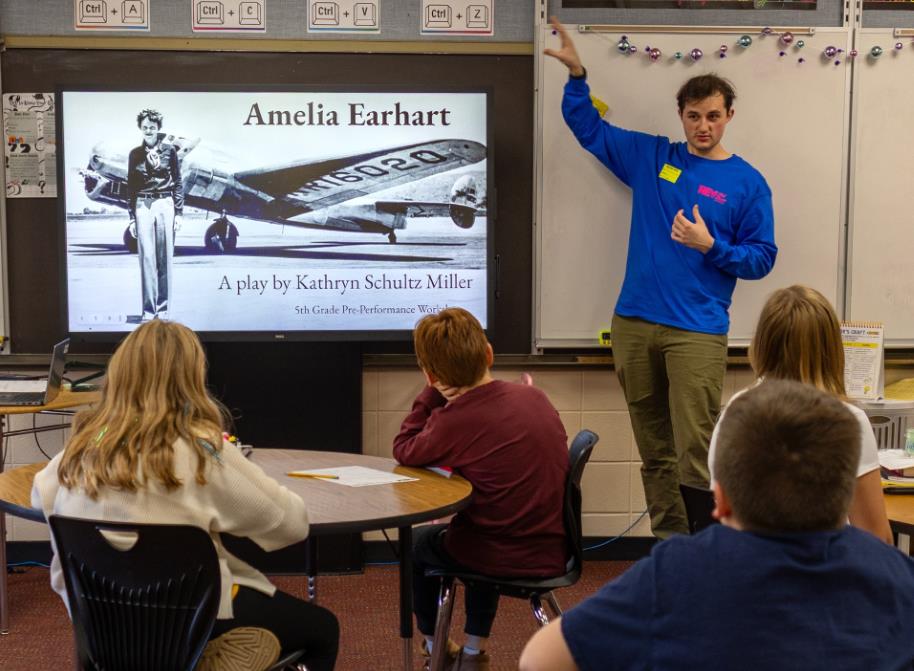
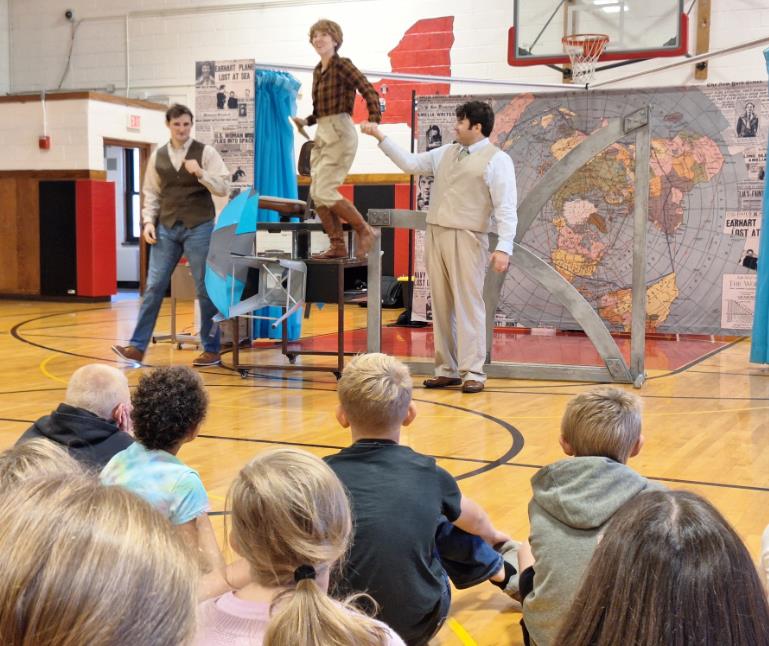
ArtReach's Amelia
Earhart - Scenes from The Rev Theatre Company Performance,
Auburn NY.
Actor
Two:
George
Putnam (G.P.) - Amelia's manager and later her husband. He was one
of the best promoters in the U.S. in the 1930's. Some say he only
married Amelia to improve his own fame
and
fortune, but their marriage endured nonetheless.
Paul
Mantz - Mantz taught Amelia how to fly the Electra for her
around-the-world flight. He was a well-known air racing pilot and
movie stunt pilot in the late 1930s.
"The
impact that Amelia has had on our nation."

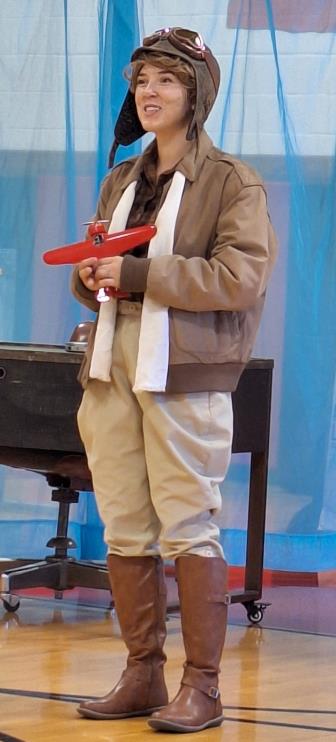
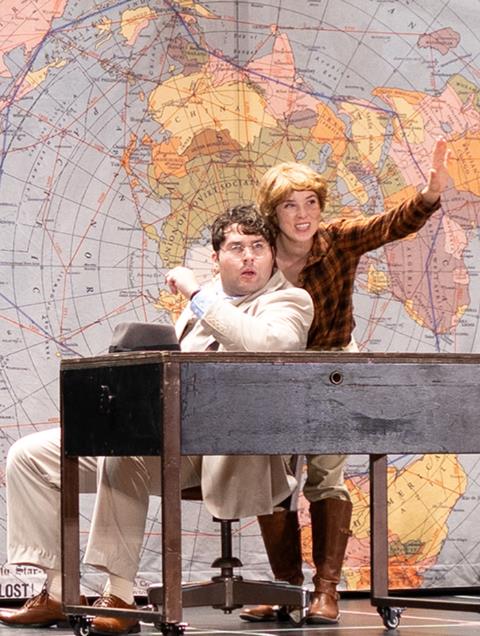
ArtReach's Amelia
Earhart - Scenes from The Rev Theatre Company Performance,
Auburn NY.
Commander
W.K. Thompson - The Commander of the U.S. Coast Guard ship that
would assist Amelia in refueling her aircraft during the final leg of
her around-the-world flight.
Actor
Three:
Reporter
- A present-day newspaper reporter for the New York Daily News who
is fascinated by the legacy and mystery of Amelia Earhart.

The
Real Christopher Robin, Biography
Background
Educational Material for ArtReach's 'Winnie-the-Pooh'
Christopher
Robin Milne (1920 - 1996) was the only child of A. A. Milne and
Daphne Milne. As a child, he was the basis of the character
Christopher Robin in his father's Winnie-the-Pooh stories and in two
books of poems.
"Each
parent chose a name, hence his legal name Christopher Robin."


Ottawa School of Theatre,
Canada - ArtReach's Winnie-the-Pooh
From
an early age, Christopher was cared for by his nanny Olive
Brockwell, until May 1930, when he entered boarding school. He called
her Nou, and stated "Apart from her fortnight's holiday every
September, we had not been out of each other's sight for more than a
few hours at a time," and "we lived together in a large
nursery on the top floor."
Christopher's
father explained that Rosemary was the intended name for their first
born, if a girl. Realizing it was going to be a boy, he decided on
Billy, but without the intention of actually christening him William.
Instead, each parent chose a name, hence his legal name Christopher
Robin. He was referred to within the family as Billy Moon, a
combination of his nickname and his childhood mispronunciation of
Milne. From 1929 onwards, he would be referred to simply as
Christopher, and he later stated it was "The only name I feel to
be really mine."
"For
his birthday, Christopher received a teddy bear."
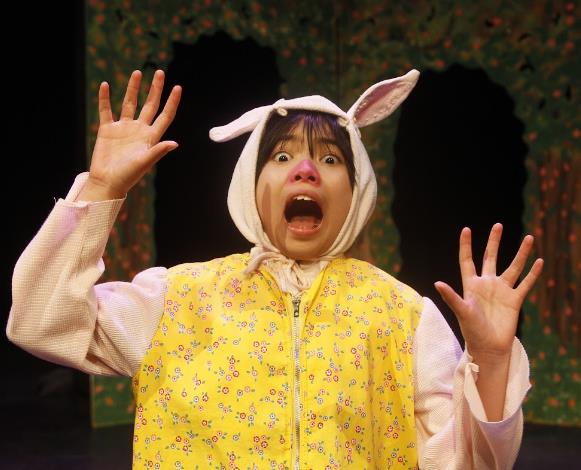
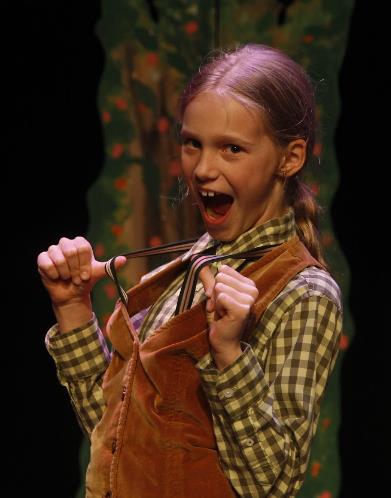

Ottawa School of Theatre,
Canada - ArtReach's Winnie-the-Pooh
At
his first birthday in 1921, Christopher received an Alpha Farnell
teddy bear, which he later named Edward. Eeyore was a Christmas
present in 1921 and Piglet arrived undated. Edward, along with a real
Canadian black bear named Winnipeg that Milne saw at London Zoo,
eventually became the inspiration for the Winnie-the-Pooh character.
The images of Milne's son Christopher Robin - the inspiration for
Milne's character of the same name who was Pooh's best pal - were
taken in 1926 and in 1928 (photos of Christopher Robin and his
father.) Mini Milne and his stuffed bear - named Edward, a gift he
received on his first birthday - sometimes come across semi-creepy,
but in that charming, vintage-photo way.
"New
generations have found much to love in
the
classic character."
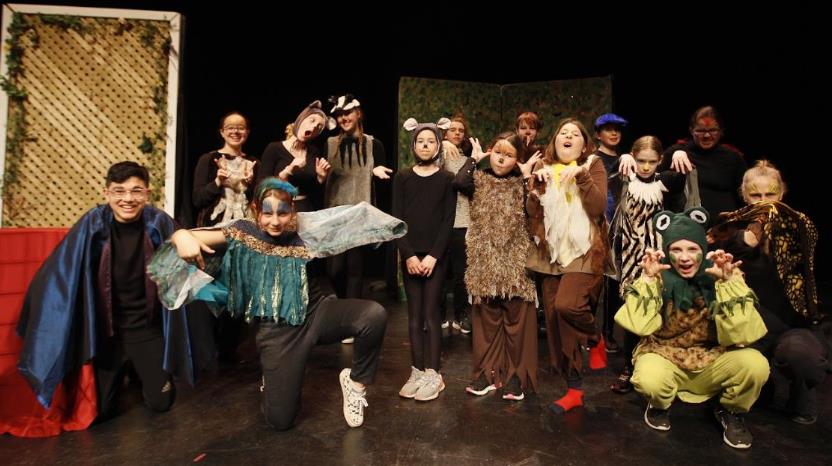
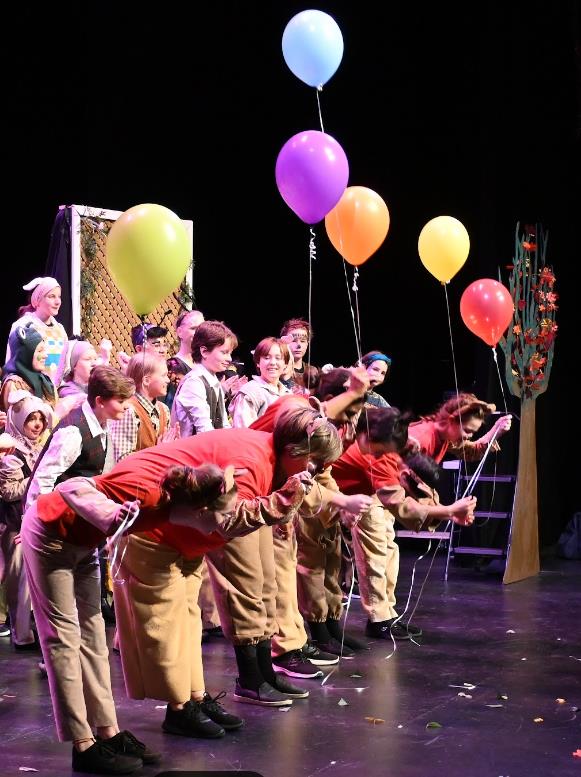
Ottawa School of Theatre,
Canada - ArtReach's Winnie-the-Pooh
There
is a somewhat sad side to the young Milne's life, however. Later in
life, he grew to resent dear old dad for thrusting him into the
public eye and essentially exploiting his childhood - or so he felt.
He published a series of his own books describing the difficulties of
growing up Pooh. He also became an atheist, which is kind of ironic
considering the religious associations people often make with Pooh.
Fans who cherished Milne's childhood book series were disappointed by
his reactions, but new generations have found much to love about the
classic character.

Why
Is The Wizard of Oz
Associated with Christmas?
Background
explains why ArtReach's A
Christmas Wizard of Oz is such a hit!
We
recently posted a review of The Wizard of Oz, one of two movies we
consider "honorary Christmas" films despite lacking actual
holiday credentials, but we didn't really investigate why it's
associated with Christmas in the first place. Fair warning: the
background here is a bit murky, so this is going to involve a bit of
speculation when it comes time to connect the dots. That said, I
think I've put together a fairly strong case for how an adaptation of
a kid's book from 1900 became tangled with the holidays despite
having no obvious yuletide connections.
"How
an adaptation of a kid's book became tangled with the holidays."
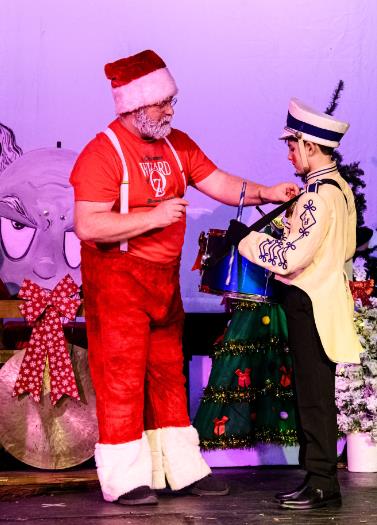
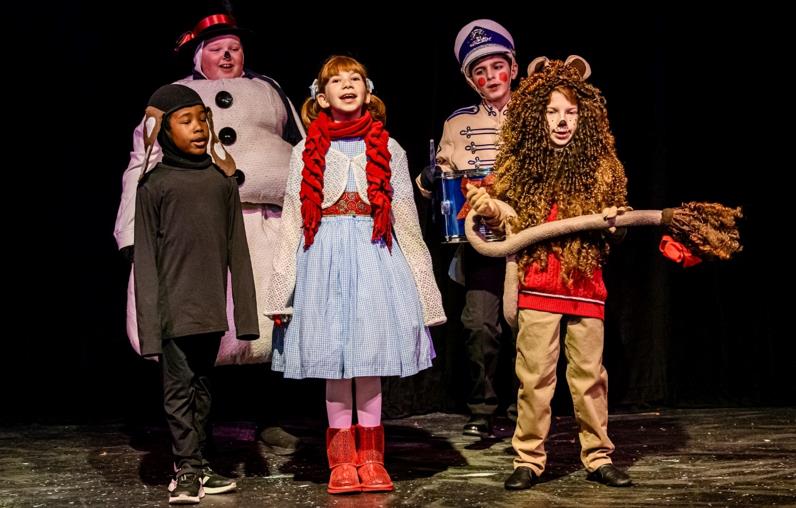
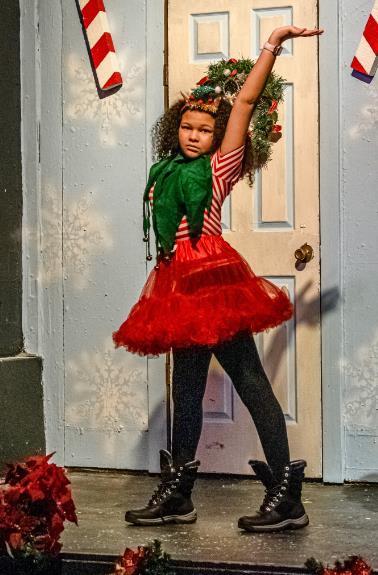
ArtReach's A
Christmas Wizard of Oz - Shawnee Playhouse, Shawnee on Delaware PA
I
think there are five primary factors at play: the movie's central
theme, its star, its signature song, its most obvious imitators, and
the decision to air it around Christmas in 1959. Let's start with
that air date, because I think it's the simplest connection.
Assuming
the list on Wikipedia is right, The Wizard of Oz was first aired on
television in 1956, when it was shown in early November. The second
time it aired was three years later, when it moved to a couple weeks
before Christmas. This appears to have briefly become an annual
tradition: CBS aired the film every December between 1959 and 1962.
After this, they shifted the movie to the spring, where it remained
for several decades. It wouldn't move back to November/December until
the '90s, but it seems to have stuck. For the past two decades, the
majority of broadcasts have been during those months. Granted, this
is unlikely to be much of a factor moving forward, as streaming
effectively negates the significance of broadcast dates, so it'll be
interesting to see if the movie's connection to the holidays wanes.
"The
song "Over the Rainbow" has become popular on Christmas albums."
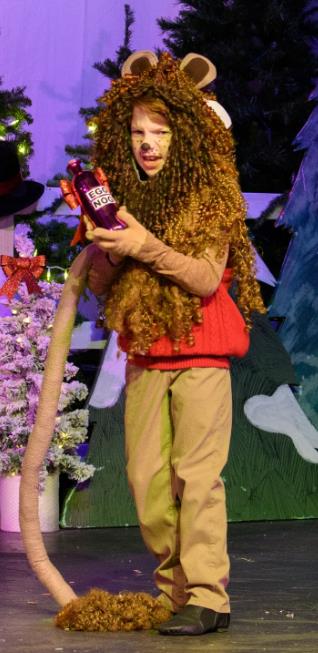
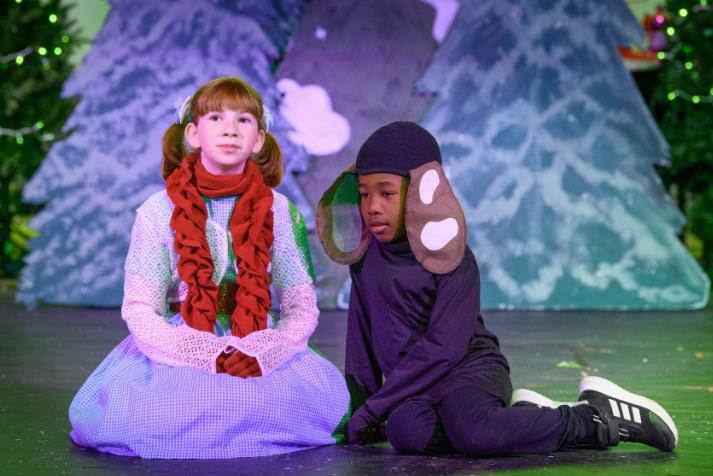

ArtReach's A
Christmas Wizard of Oz - Shawnee Playhouse, Shawnee on Delaware PA
When
I mentioned imitators, I was mainly referring to adaptations of
Babes in Toyland, particularly the 1961 Disney version and 1986
made-for-TV movie. While Wizard of Oz doesn't connect directly to
Christmas, Babes in Toyland absolutely does, thanks to the presence
of Santa Claus. There is of course no shortage of movies influenced
by Wizard of Oz (it's arguably the archetype of modern blockbusters),
but most of these involve structural design or production strategies.
Babes in Toyland resembles Wizard of Oz in a number of surface-level
ways: it looks like Oz (or at least a cheap knock-off) and is set in
a similar fairytale world. My suspicion is these sort of got jumbled
together in the popular consciousness and as a result, Oz was pulled
closer to the holidays over time.
Two
other major two factors are related. I suspect one reason the song
"Over the Rainbow" has become a popular inclusion on
Christmas albums is it's originally sung by the movie's star, Judy
Garland, who's also well known for singing "Have Yourself a
Merry Little Christmas." This may be a tad reductive, though: I
suspect there was a sort of feedback loop occurring where "Over
the Rainbow" became more associated with Christmas over time,
leading to Garland becoming even more associated with the holidays,
and so on. Regardless, the song even eventually showed up on a
posthumous Christmas compilation of Garland songs, along with
numerous other Christmas albums from other artists.
"Dorothy's
nostalgic longing to return to her family farm in Kansas."
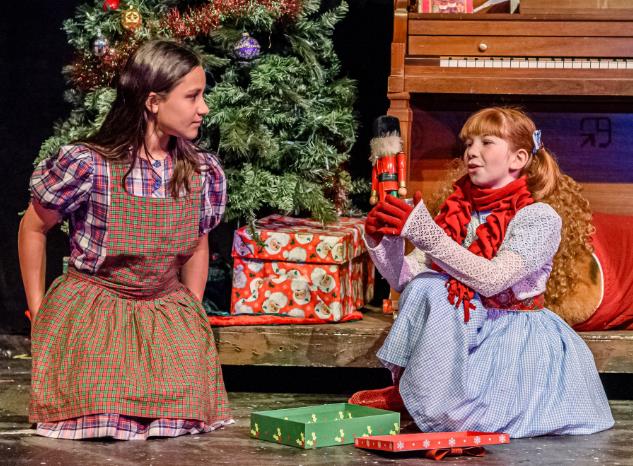
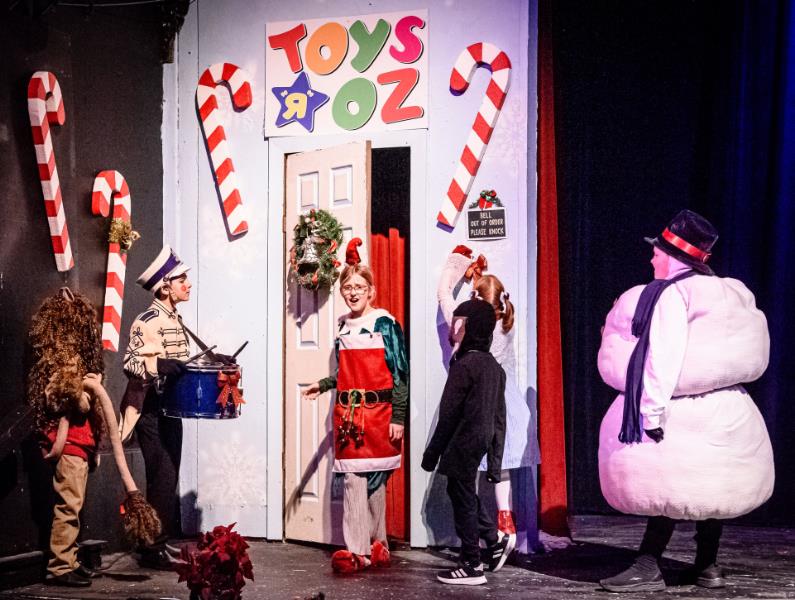
ArtReach's A
Christmas Wizard of Oz - Shawnee Playhouse, Shawnee on Delaware PA
A
less obvious reason might relate to a central theme of the movie,
namely Dorothy's nostalgic longing to return to her family farm in
Kansas. When the movie was released in 1939, this wouldn't have
seemed particularly Christmassy, but that would change fast.
I've
written in the past about how America recontextualized Christmas
during and after World War II. While nostalgia has long been an
aspect of Christmas stories, the war magnified and codified this
theme. Immediately after the war, Christmas movies became fixated on
the desire to return to a more innocent time and place, largely
symbolized by rural farms and old-fashioned celebrations. Longing to
get home for Christmas during trying times resonated during and after
the war, as soldiers and their families naturally found themselves
missing being together. Music embraced this idea, as well, and somber
songs struggling between themes of loss and hope became the norm (a
trend lasting to this day - Christmas songs popularized after the war
are the same tunes radio stations subject us to now). Wizard of Oz
fits in fairly well with this style of holiday film, and the wistful
tone of "Over the Rainbow" isn't appreciably different from
songs like "White Christmas" or "Have Yourself a Merry
Little Christmas."
"A
Christmas Wizard of Oz fits in well with the holidays."

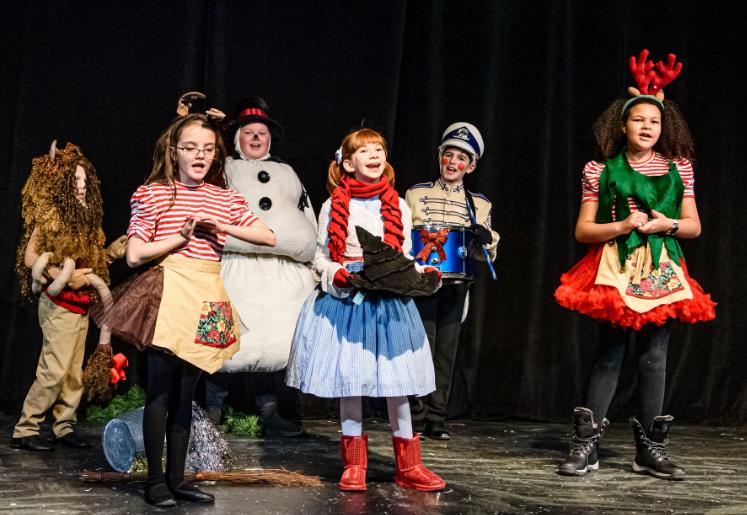
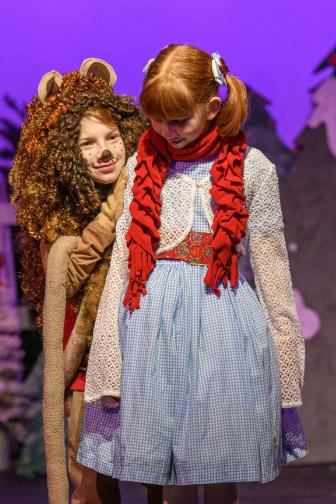
ArtReach's A
Christmas Wizard of Oz - Shawnee Playhouse, Shawnee on Delaware PA
I
suspect all these factors sort of played off each other. Wizard of
Oz felt enough like a Christmas movie to justify running it near
Christmas, which in turn seeded an association between the two in the
minds of a generation of kids. As that generation grew up, they
started incorporating "Over the Rainbow" in Christmas
albums, which increased the strength of that connection and led to
holiday-themed merchandising (Hallmark's Oz ornaments being the
obvious example). Over time, Oz at Christmas became something of an
expectation, which broadcasters exploited.
To
be clear, this is speculation - there could be other factors I'm
missing, or I might be giving too much weight to some over others.
But I can't seem to find a great deal written on the subject online,
and I think the factors above offer a likely explanation. By
Erin Snyder. Thank you!

Here
is the story of ArtReach's Pinocchio
from the Teachers Guide
How a Puppet
Became a Real Boy: Pictures of Sutter Street Theatre's Production (CA)
As the play
begins we are transported to an Italian village where "Lorenzo
Magnifico's Magnificent Carnival of Puppets!" is playing today.
Lorenzo introduces his magnificent puppets and puppeteers who are
given the task of telling today's story.
Not long into
the storytelling the proceedings are interrupted by an audience
member. But this is no ordinary audience member - indeed, it is a
Talking Cricket named Hickory Cricket. Hickory has some curious news
about a puppet who talks and walks like a live person. So begins
Pinocchio, the story of a puppet who wants to become a real boy.
In his lonely
workshop the old wood carver Geppetto delights in his creations -
Ivana the Wooden Dancer, his Music Boxes and Cuckoo Clocks. It is all
very well to have their company but Geppetto looks at his wooden
puppet Pinocchio and wishes he were a real boy. His Lucky Star shines
and as Geppetto falls asleep the Blue Fairy comes to Geppetto and
grants his wish. She waves her wand and Pinocchio comes to life.
"Geppetto
wishes Pinocchio was a real boy."
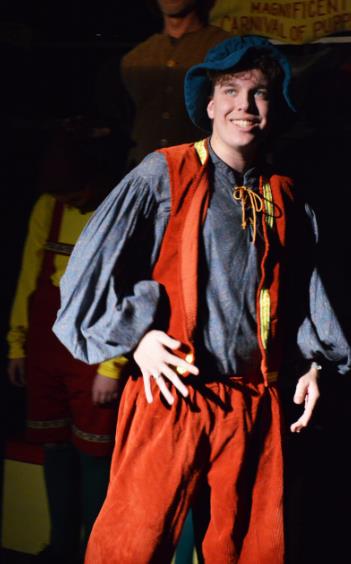


Sutter Street
Theatre's Production of ArtReach's Pinocchio
But the Blue
Fairy tells him, he is not yet a real boy and cannot become one until
he proves that he is good and honest. Pinocchio pledges to prove
himself and the Blue Fairy appoints Hickory Cricket to look after him
in his adventures. When Geppetto wakes his is overcome with joy.
Geppetto
dresses Pinocchio and gives him school books and money and sets the
puppet off to school. Along the way Pinocchio is sidetracked by
Fibber the Fox and Lefty the Cat. They scheme to divert Pinocchio,
sell him to Lorenzo and get their hands on Lorenzo's money. Pinocchio
is completely duped by these tricksters and forgets all about school
and Hickory, letting them lure him with promises of getting into show business.
But Lorenzo is
not happy with his purchase, telling Pinocchio that people want to
see a puppet who can dance. But Pinocchio cannot dance and Lorenzo
locks him in cage until he learns how. Pinocchio calls for his friend
and Hickory appears but, alas, the Cricket cannot free Pinocchio from
his predicament.
The Blue Fairy
appears and questions Pinocchio. Pinocchio lies about his actions and
his nose begins to grow. She reminds him of his promise to become
honest and good and sets him free to try again.
"Pinocchio
is duped by tricksters and forgets all about school."
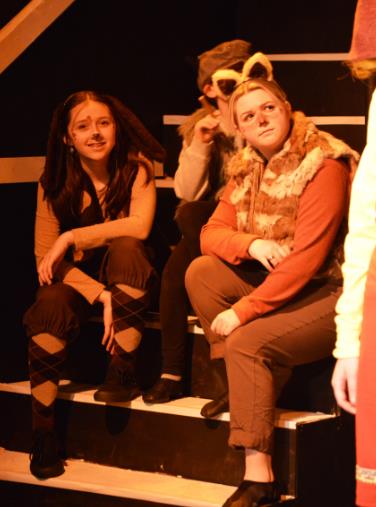
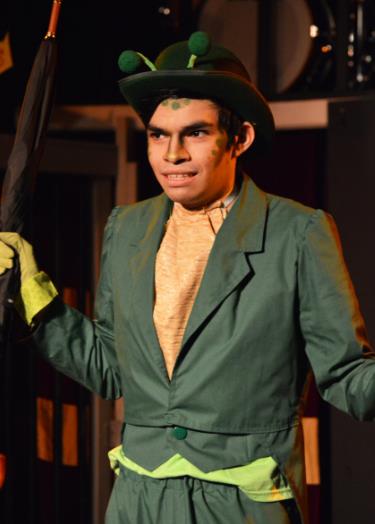

Sutter Street
Theatre's Production of ArtReach's Pinocchio
Pinocchio and
Hickory set off for home but Pinocchio is once again lured away from
his goals when he meets up with Lampwick, a real boy who is running
away from home. Lampwick is all bluster and swagger when he tells
Pinocchio of Land of Toys where there are no schools and it's always
vacation from New Year's Day to Christmas. Pinocchio is duped again
and hops a ride on the coach that is carrying children away to the
sinister Land of Toys.
Pinocchio and
Lampwick have a great time being cool and having fun all day until a
strange thing happens. Lampwick and the other children begin to grow
ears and bray like donkeys. When he learns that the boys who have
become donkeys are being loaded onto a ship Pinocchio calls for
Hickory and once again the good Cricket flies to his side.
They set off
for home only to find that Geppetto has gone away. The Blue Fairy
tells them that Geppetto has gone to the sea to save Pinocchio from
the Land of Toys. Worst of all - Geppetto is at the bottom of the
sea, living in the belly of a Terrible Whale.
At last
Pinocchio musters all his courage and goodness and swears to save his
dear Papa. Hickory and Pinocchio dive into the ocean and are
swallowed by the Terrible Whale. Inside they find Geppetto but it
seems all is lost - how can they escape the whale before they starve
to death?
"The
Blue Fairy appears and waves her wand."
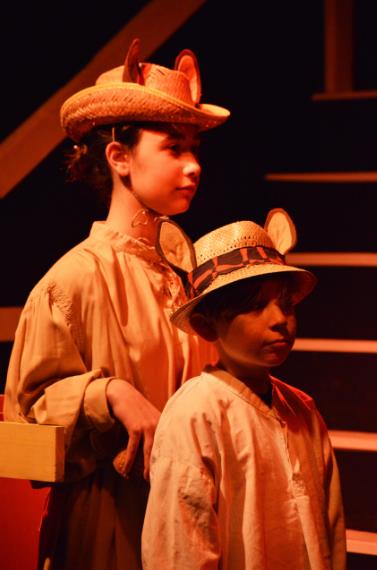

Sutter Street
Theatre's Production of ArtReach's Pinocchio
Pinocchio
becomes the hero when he builds a fire and causes the whale to
sneeze! They are rushed on a wave to shore but Pinocchio is lifeless
and does not open his eyes. The Blue Fairy appears and waves her
wand. Pinocchio has proven himself and she tells him he is now a Real Boy.
When Pinocchio
awakens Geppetto is overjoyed and the old man and his real son are
together at last. Lorenzo reminds us once again that we are
witnessing his magnificent puppets and asks for the audience
applause. Puppets dance and sing and all players return to the stage
for their bows.
But the ending
is not complete until Hickory joins Pinocchio on stage and declares
that wishes really do come true!

ArtReach's
"The
Emperor’s New Clothes"
STUDY
GUIDE SYNOPSIS
The
Emperor’s New Clothes is Hans Christian Andersen’s
classic tale of vanity and foolish pride. Now Children’s Theatre
Plays brings the story to life. Join crafty Peter as he plots to
embarrass the Emperor and make off with a basket of gold.
Everyone
gets into the act as audience members are recruited to help spin the
magic cloth!
"Everyone
gets into the act!"


Main Stage Playmakers at the
Center, Grass Valley CA - ArtReach's The
Emperor's New Clothes
The
play opens as the Orchestra Members introduce the play with their
percussion instruments: drum, bell, horn, triangle, whistle, kazoo.
They get the whole thing started with a hilarious fanfare and so the
play begins!
His
Grandmother tells Peter that, because of his laziness, they are dirt
poor and have nothing to eat. Peter vows to go to the big city and
become rich. Grandmother just laughs. “Go back to playing tricks
and games, Peter,” she tells him.
But
Peter has made up his mind and sets out for the Russian city of
Kostroma, the most prosperous city in the empire. When he arrives he
is tired and very hungry but the street merchants tell him he must
have money to buy their food. Soon he meets with a Blacksmith who
tells him of the Emperor and the royal procession that is to be held
on Saturday. The Blacksmith tells Peter of the Emperor’s
obsession with beautiful clothes. Suddenly Peter has an idea. “I
shall be rich!” he declares.
Peter
goes to the Emperor’s palace and tells the Empress that is a
very clever tailor – that he can make clothes that are magic!
Finally he convinces her to let him in the palace. Peter hides
as he spies the Emperor walking in his sleep, having a nightmare. The
Emperor dreams that his people are claiming that he is not a good
Emperor, that he is unfit for the office that he holds. Peter
knows just was to do with this knowledge. When the Emperor
awakens, Peter claims that his magic clothes have a very special
power. “this cloth,” he says, “is invisible to anyone
who is unfit for the office that he holds or is very stupid”.
Peter
the Tailor has an idea. “I shall be rich!”
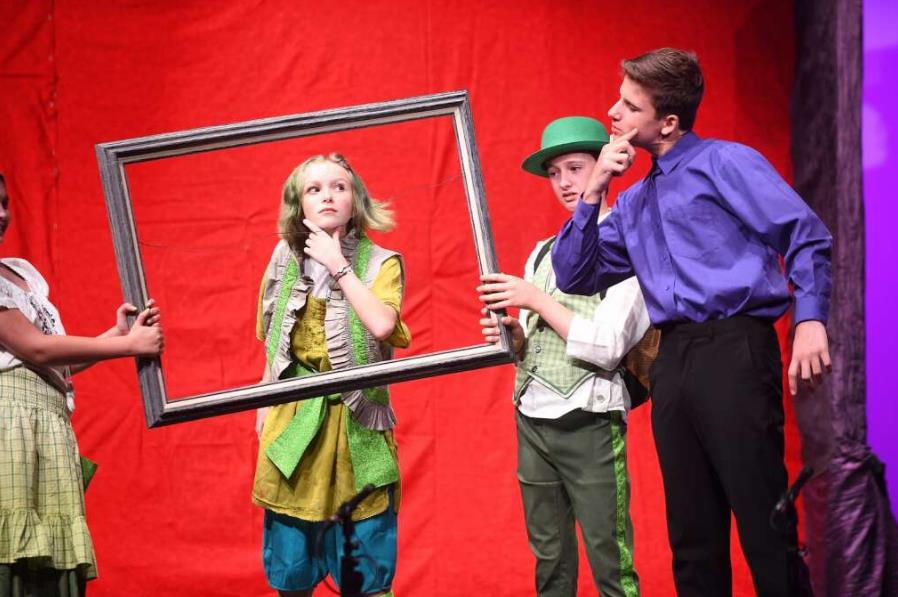
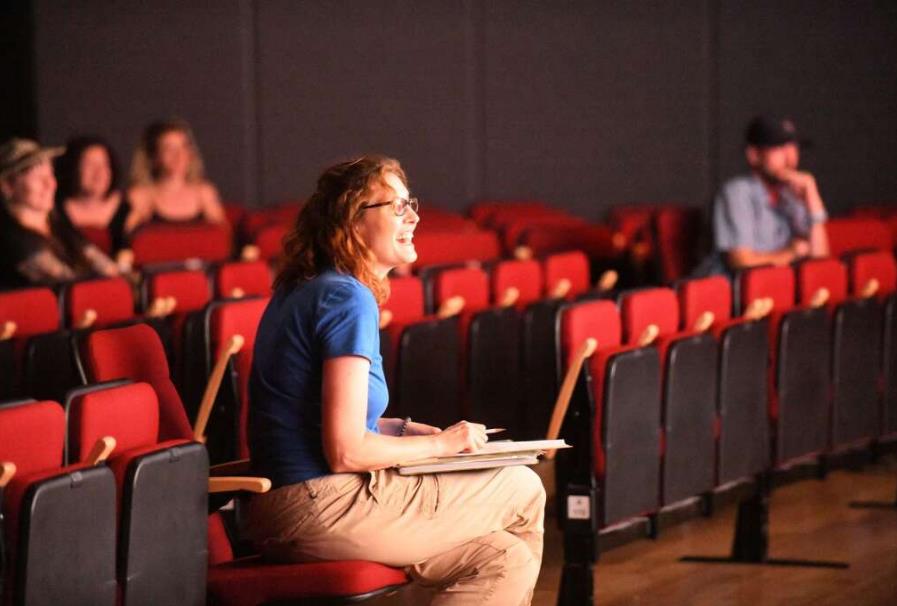
Main Stage Playmakers at the
Center, Grass Valley CA - ArtReach's The
Emperor's New Clothes
The
Emperor and Empress are amazed and agree to have Peter make his
clothes for the upcoming procession. Peter asks for baskets full of
golden thread and jewels, planning to make off with the loot before
the Emperor discovers his scheme. Peter has no idea how to weave
cloth so he asks the audience to help him out.
Their
sounds convince the Emperor that Peter is doing his work. Now the
Empress and the Cabinet Ministers come to view the cloth. Peter
is betting they will say they love the beautiful cloth even though
there is nothing there because they do not want to be considered
stupid. Peter'’ plan works and finally when the Emperor see the
cloth he too pretends to see it! After all, he doesn’t want
anyone to think he is unfit for office.
But
the Emperor foils Peter’s plans by insisting that Peter stay
for the procession on Saturday. Peter had hoped to take off with the
riches but has no choice but to stay for the parade. He hopes that
everyone in the village will pretend they see the clothes because
they do not want to be considered stupid.
"The
Orchestra tells us - they all lived happily ever after."

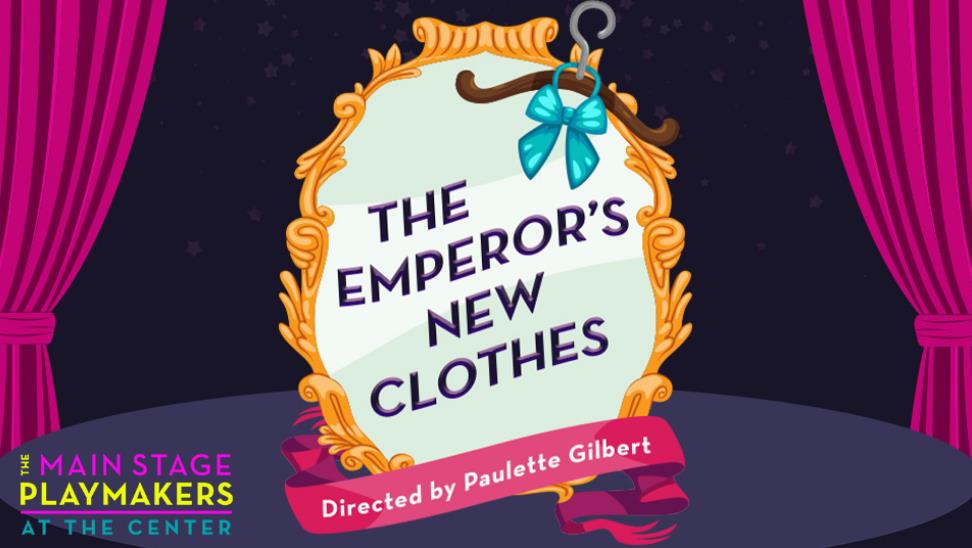
Main Stage Playmakers at
the Center, Grass Valley CA - ArtReach's The
Emperor's New Clothes
The
procession begins with the hilarious sight of the Emperor standing
proud and regal – in nothing but his silly underwear! Just as
the Emperor is about to bestow a high honor Peter, a child in the
audience (audience member) calls out, “The Emperor has not
clothes on!” suddenly the Emperor sees he has been tricked and
chases Peter through the audience. Peter must run away, leaving
behind all the riches he had hoped to take home.
Peter
runs home to his Grandmother and tells her the fantastic story of
his adventure as the Emperor’s tailor. Of course, she
doesn’t believe him and explains that while he was goofing off
she had to sell his bed to get money for food. Peter will have to
sleep on the floor or as his Grandmother laughing suggests, make a
bed, “like you made the Emperor’s suit&ldots; with magic.”
The
play ends as the Orchestra begins to wrap up the story and all
member of the cast begin to take their bows. From the back of the
house the Emperor chases Peter on stage and peruses him as he hides
among the cast members who are taking their bows. In then end all
actors who have played the part of Peter hop on stage, the Emperor
chases them all out of the theatre. And as the Orchestra tells
us&ldots; they all lived happily ever after.
“Every
man's life is a fairy tale written by God's fingers”
Hans
Christian Andersen

For
ArtReach's Robin
Hood, Grab Your Bow and Arrow!
Archery
for Beginners
There
are 11 steps to successful archery in the NASP program and when used
with each shot, molds a masterful archer.
Stance-the
archer straddles the shooting line with one foot on either side,
with the inside toe a half step toward the target. The archers' then
place their bow on the inside toe to prove they are ready to shoot.
"11
steps to successful archery."
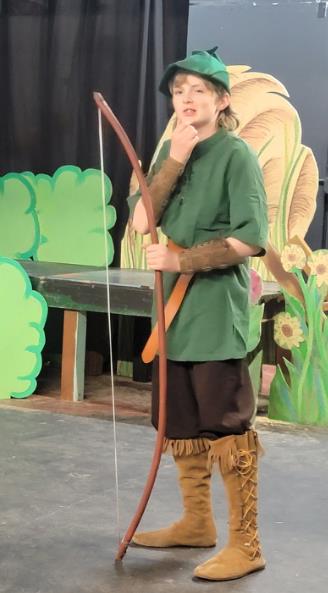

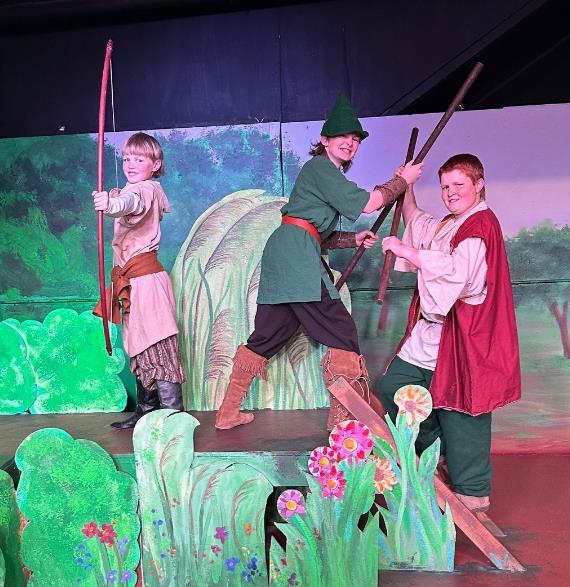
ArtReach's Robin
Hood - Eastern Oregon Regional Theatre,
Baker City
Nock-the
nocked end of the arrow is inserted into the bow string with the
draw hand.
Draw
hand set-three fingers grip the bow string with the pads or the
first joint of the fingers.
Bow
hand set-the archer places the bow in the bow hand with the meaty
part of the thumb inside the grip to the lifeline of the palm.
Pre-Draw-the
archer lifts her arm allowing it to hinge at his shoulder so the
shoulders remain level.
"Archer
focuses on the target with the dominate eye."
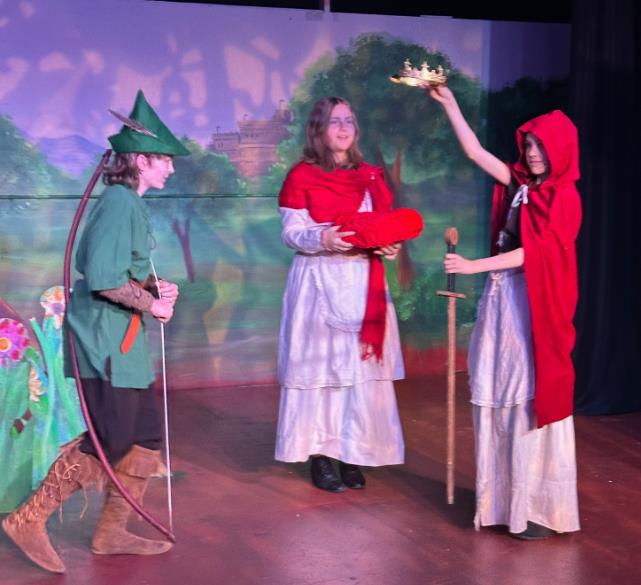
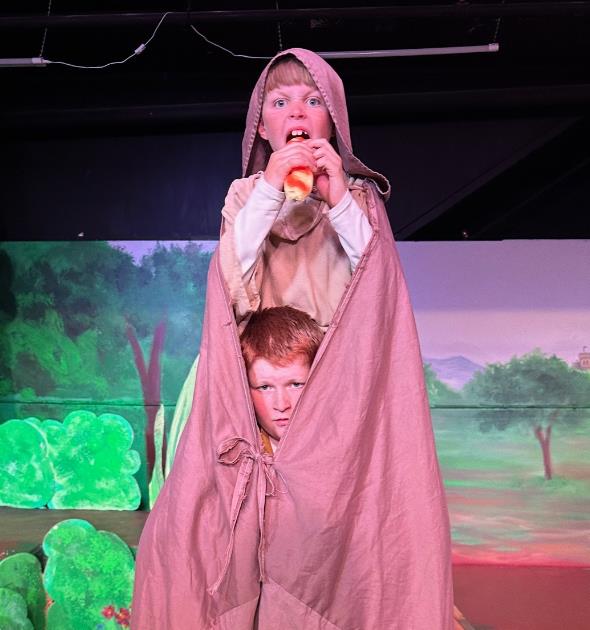
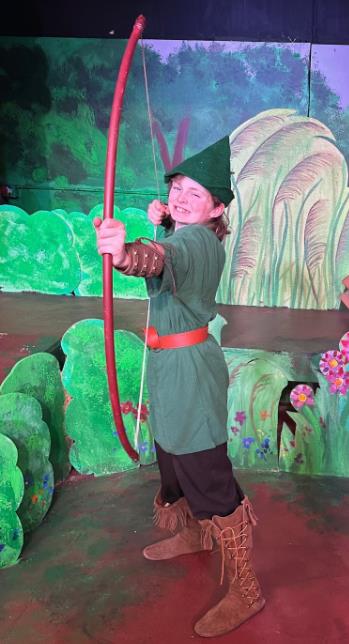
ArtReach's Robin
Hood - Eastern Oregon Regional Theatre,
Baker City
Draw-smoothly
pull or draw the string toward the right side of the archer's face.
Anchor-the
index finger rests at the corner of the archer's mouth.
Aim-when
the archer focuses on the target with the dominate eye.
Shot
set-up-the archer presses her shoulder blades together, transferring
energy from arms to back, chest out.
Release-when
the archer relaxes her fingers and back of hand from the string,
releasing the arrow.
Follow-Through/Reflect-upon
release, the draw hand moves rearward, along the face and under the
ear with fingers relaxed and reflects on the upon the position of the
draw and bow hand to see that they are in the proper ending position.

The
Legend of Sleepy Hollow
Aurora
Children's Theatre Study Guide
Ichabod's
Life Lessons: Sleepy
Hollow's flawed characters and what they can teach us. The
characters in The
Legend of Sleepy Hollow all contribute to the unfortunate end.
From each of these characters we can learn how selfish acts, and
working against each other, rather than with one another can lead to
unfortunate incidents.
Sleepy
Boy: The
Sleepy Boy from the beginning of our tale immediately doesn't like
Ichabod Crane because Mr. Crane is different than the Sleepy boy.
This kind of thinking is closed minded and unfair to the person being
judged. Thinking to yourself that you do not like someone just
because they are different could be holding you back from meeting
someone you would actually like and become friends with.
The
Lessons of Sleepy Hollow
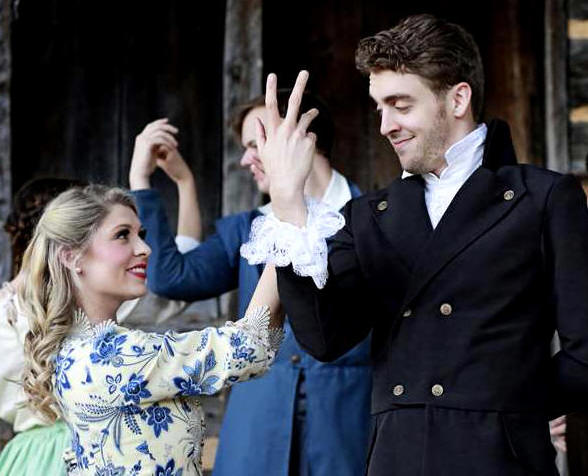
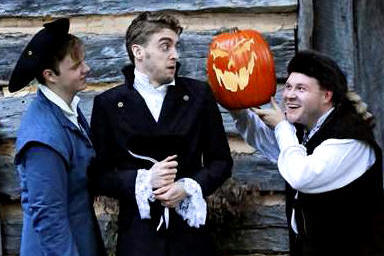
ArtReach's The
Legend of Sleepy Hollow - Jonesborough Repertory Theatre, TN
Brom
Bones: Brom
is a character who revels in making others feel small to make
himself feel better. He finds the weakness that Ichabod has, and
continually uses this against him. This tactic eventually works in
Brom's favor, but at the cost of hurting someone. On top of hurting
Ichabod, the satisfaction Brom obtains will never last. He is ahead
of the game for only a short while, as Katrina already has a new beau
in mind.
"Ichabod
allows himself to get distracted."
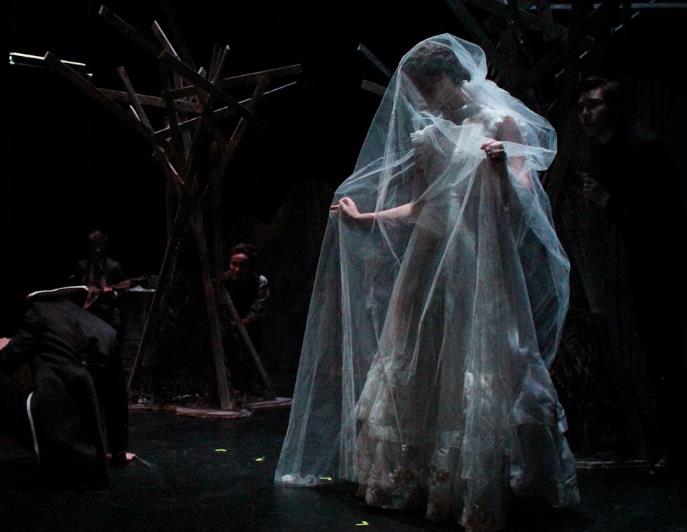
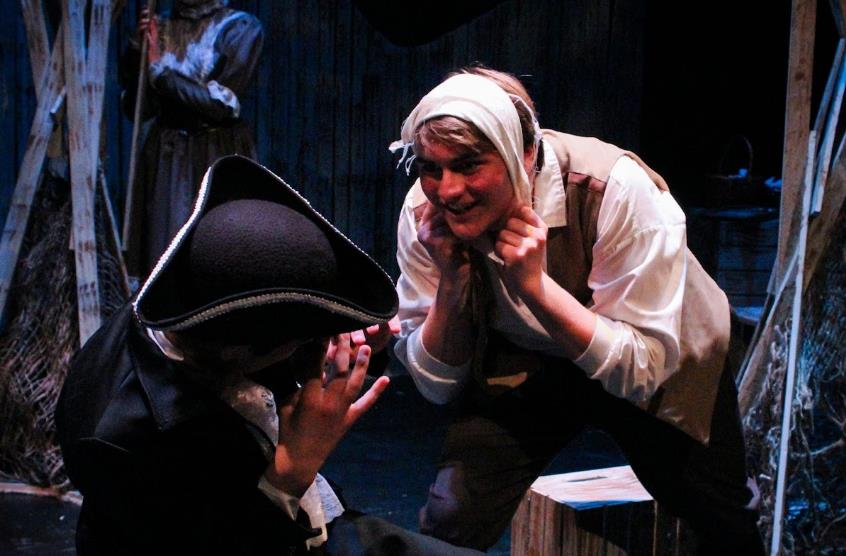
ArtReach's The
Legend of Sleepy Hollow - Winthrop High School Drama, Winthrop MA
Ichabod
Crane:
Ichabod is a man distracted by fear and greed. Ichabod allows himself
to get distracted by his greed, which leads to his fighting with
Brom, and eventually his own downfall. Ichabod letting his fears get
the best of him is how Brom eventually "wins" the game he
and Ichabod are playing.
Katrina
Van Tassel: Katrina
uses both Brom and Ichabod to get what she wants. This is another
catalyst to Ichabod's downfall. Establishing relationships with
others will eventually render reward, sometimes in the form favors,
but what is important is the bond you establish with the other person.
A
Christmas Peter Pan Classroom Ideas
Lesson Ideas
– A Christmas Peter Pan
The classic tale of Peter Pan
explores the world of fantasy and imagination. The popular story,
also captured on film and written by James Matthew Barrie in 1904,
has captivated audiences for decades. Take your students on a journey
of exploration with Peter Pan and the gang through the world of
Neverland. Adapt a lesson plan for K-12 students from math to
physical education with Peter Pan classroom activities.
Walk
the Plank Vocabulary: The menace of the story of Peter
Pan is the pirate, Captain Hook. Gather your students and invite them
to test their vocabulary knowledge aboard Hook's plank. You can
create a plank out of cardboard or wood or alternatively use tape or
other items to identify the tip of the plank. Using words from the
book like "engrossed," "spinster" and
"subtle," ask the students either how to spell or define
terms. Every mistake means one step closer to the edge of the plank.
After hitting the edge students are eliminated from the game until
there is one player left.
"Peter
Pan explores the world of fantasy and imagination."

ArtReach's A
Christmas Peter Pan -
C-pac Theatre Company, Columbiana, OH
Neverland
Math: Create mystical math questions for your students
to solve using the Peter Pan theme. For younger grades stick to
simpler equations using addition and subtraction. For example, if
Peter Pan has three wishes and he uses one, how many does he have
left? For higher level students you can create tougher questions
using multiplication, division and word problems. For example, if
Captain Hook has a treasure chest with 100 pieces of gold and Peter
Pan takes half but drops half while getting away, how much gold does
Peter bring back to Wendy?
Hook's
Treasure Hunt: Take your students on a hunt around the
world to locate Hook's treasure. All you need is a map or globe of
the world and a few stickers to mark the spot. You can perform this
activity one of two ways. One requires you to mark the map prior to
the game and have the children identify the city and/or country of
each mark. You may also present the clean map or globe to the class
and name cities or countries that the students must locate and mark
on the map.
Peter
Pan: Keep your students active with physical
activities based on Peter Pan. For younger students, play a variation
of Duck, Duck, Goose entitled Peter, Peter, Pan. Seat the kids in a
circle with one child, known as Captain Hook, walking around lightly
tapping the heads of his peers exclaiming "Peter" until he
lands on the one he wishes to race. He must exclaim "Pan"
when tapping the head to initiate the race. The two students, Peter
and Hook, must run around the circle. If Peter manages to tag Hook
before he sits in Peter’s spot in the circle, the student
playing Peter now plays Hook and gets to tap heads around the circle.
"Explore
the world of fantasy and imagination."
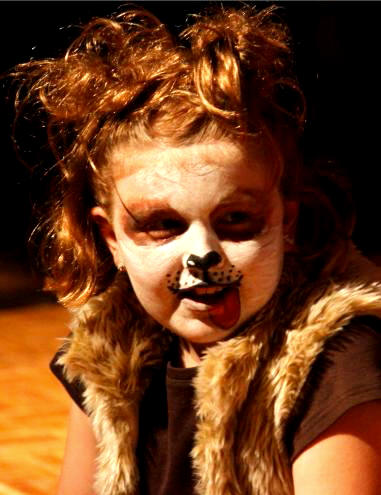
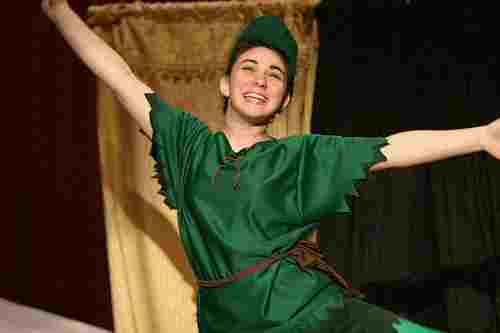
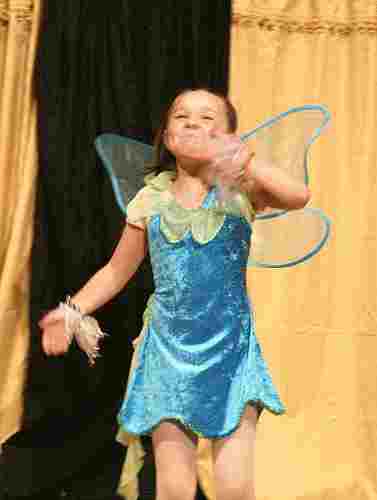
ArtReach's A
Christmas Peter Pan, North Shore Children's Theatre, Salem, MA
DISCUSSING THE
PLAY, CHARACTERS, IDEAS, ETC.
SNOW
FAIRIES: Ask the class to pretend that they are
snow fairies. What is your name and what do you look like?
Where do you live and why? Do you have a magic wand, or could
your special powers be in your shoe or your hat? What are your
magical powers? If the sun was shining brightly on you, what
would you do? Show how you would do it.
CHRISTMAS
CAROLS: Which are
your favorite Christmas Carols and why? Have everyone sing a
Christmas Carol. Now pretend you are a pirate singing the
song. What words would you change to make it sound more like a pirate?
CAPTAIN
HOOK TREASURE MAP: Choose Christmas tree
ornaments to be treasures. Hide them on the around the school
or on the playground and let the children find them like an Easter
egg hunt. Have them draw a map from their desk to the place
where they found the treasure. Look at places on a map or a
globe where pirates once sailed such as the Caribbean and Spain.
Find your home on the map and trace the way to the nearest port and
then to the place of the pirates’ origin.
SANTA
ELVES: If you were an
elf what would your name be and what kind of toy would you make?
What kind of materials would you use? Paper, wood, plastic,
glue? What tools would you use? Are these in your
garage at home or would you need to invent special magical tool? How
long do you think it would take you to make such a toy? Who
would you give your toy to? Draw picture of the toy you would
like to give your best friend or family member.
CROCODILE:
Have everyone draw a picture of a crocodile. How wide is your
crocodiles mouth, how big are his teeth? What does he like to
eat the best? Discuss the difference between crocodiles and
alligators. Look up where they live and find them on a
map. Do you think a crocodile would rather live in a zoo or in
the sea?
PIRATE’S
SHIP: Draw a picture of a pirate ships and
identify the various parts of the ship: main deck, rigging,
mast, sails, port, starboard, bow, stern. Pretend that you are
a pirate and you are being attacked by another ship. What kind
of treasure do you have on board and what will you do to protect
it? Pretend the Captain is a villain like Captain Hook and
stage a mutiny.
Classroom
Activities for Kid Frankenstein
Talk, Write and
Perform Kid Frankenstein
Mad
Scientist:
The idea of the Mad Scientist is that the scientist loves his work so
much he takes it too far. Think of other professions,
especially those you aspire to be. Talk about what can go wrong
when someone takes their ambitions a little too far.
Suggestions: Astronaut, Baker, Football Player, Librarian, School Bus Driver.
Create
Your Own Silly Monster:
Think of all things you think are funny. Tutus, chickens, top
hats, tricycles, wigs, even things from your freezer or
refrigerator. After you have named these things, draw your own
monster incorporating these objects as part of the monster. For
instance, your monster may have a beak like a chicken and wear a tutu
and a top hat. What magical powers does your silly monster have?
"What
is your favorite monster?"
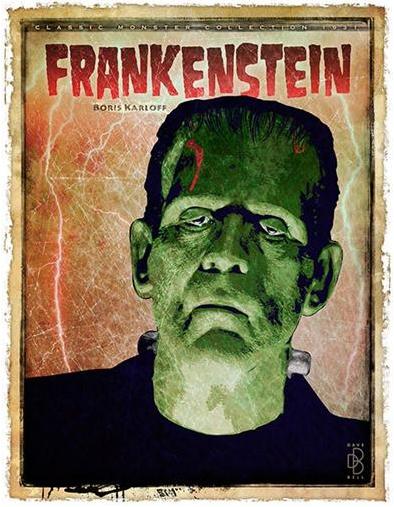
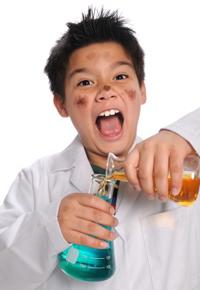

"Crazy am
I? We'll see if I'm crazy or not!" - Mad Scientist Frankie Stein
in ArtReach's play 'Kid Frankenstein'!
Youth Summer Theatre Program,
Grand Rapids, MN
Create
Your Own Laboratory: Have each
student bring in or draw a picture of something in their own home
that could become a part of a magical laboratory where anything can
happen. Look for objects with electric cords, knobs, wheels,
dials, buttons, etc. Pretend the object has a magic
power. Demonstrate that power to the class. Now
have students put their magic objects together to make a
laboratory. Demonstrate your laboratory’s process and what
is the outcome of the function? Frankie chose to
make a Frankenstein monster in his laboratory. What would you
like to make?
Dress
as Monsters:
What monsters are your favorites? Have kids come to school
dressed as their favorite monster. This can be especially fun
on the day of the performance of Kid Frankenstein – especially
if it’s around Halloween!
Real
Life Monsters:
Monsters are just a figment of our imaginations. Monsters come
from people looking at real creatures and assigning them super
powers. Think about real life animals and natural objects
like gnarly trees and clouds in the sky. Imagine that you see
monsters in these objects that come to life. What do they look
like? What powers do they have?
"What
magical powers does your monster have?"
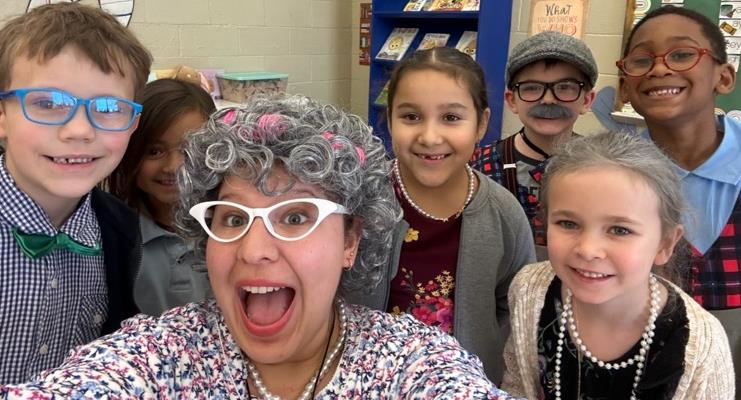
Immaculate
Heart of Mary School, Little Rock AR
Frankenstein
at the Movies! Show classic
movies such as Frankenstein (1931), Bride of Frankenstein and Young
Frankenstein. If you are short on time or wish to cut out
certain scenes, just show excerpts. Pop some
popcorn! Throw blankets on the floor and let kids sit on
the floor. Tell them if they get too scared to grab each
other and scream their heads off! That’s part of the
fun. And remind them that nothing in the movie is real.
Afterwards talk about scary movies and how to keep from getting too
scared by them.
"Logic
will get you from A to Z; imagination will get you everywhere.”
-- Albert Einstein
Creative
Dramatics and More Fun Ideas for Jack
and the Beanstalk!
Have Classroom
Fun with this
Famous Mountain Jack Tale
Appalachia:
Has anyone visited the Smoky Mountains? Do they know of anyone who
hiked the Appalachian Trail? Tell the class about your experiences.
What did you like best about the area? Have everyone imagine a
favorite mountain or valley spot and draw a picture. Draw children in
the picture. How do they spend their days? Imagine yourself in the
deep dark woods. Is it peaceful? Describe the things that live in the forest.
Cows: If
you were going to dress up as a cow for Halloween, how would you
look? What kind of costume pieces would you need to be a cow? If
there's a cowbell around, ring it for the class and talk about its
uses for farmers. Ask kids, do you like the sound? Do you think cows do?
Magic
Beans, Crazy Creatures & Giants in the Sky!
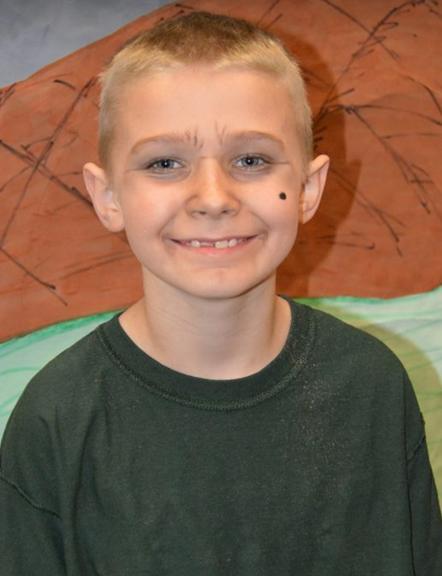

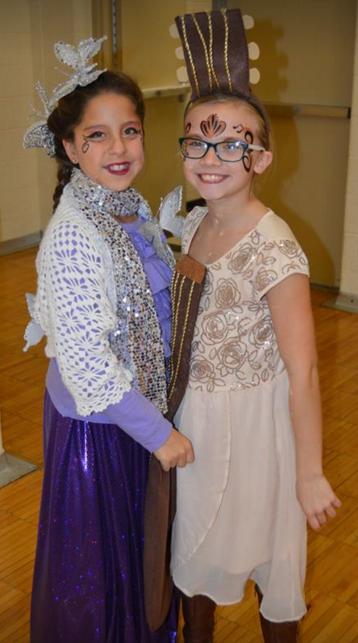
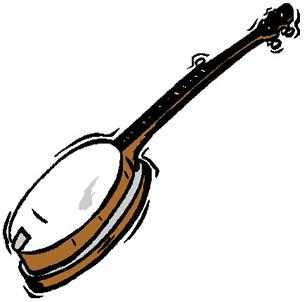
Jack
in the Beanstalk is one of ArtReach's most popular musicals!
Folksongs: Folk
music is fun because it's music that anyone can join in with! And
it's interesting because every single culture has their own folk
music! There's English folk music, Scottish folk music, Welsh folk
music, Irish folk music, American folk music, South American folk
music, Polish folk music, Hungarian folk music, Russian folk music,
Australian Aboriginal folk music and on and on. Can you name a song
that you have learned in your class that is a folk song? Find out
what country or region it is from. Locate it on the map and look up
other songs from that area. You may be surprised how many you know!
Ask the music teacher to devote a session to old folk songs and new
songs that sound like folk songs.
Crazy
Creatures: Jack was afraid of purple-eyed monsters, horny-toed
dragons and warty-faced giants. What kind of scary beings do you
imagine? Make a mask out of construction paper or foam. Show the
class how your scary creature walks and talks. What does he eat? Are
they afraid of him too?
For a fun creative dramatics
exercise, have each student choose a characteristic from the first
column and a type of creature in the second. Combine the two, become
the crazy creature and sing Polly Wolly Doodle as your creature would.
IItchy-eared
Elephant
Lizard-tongued
Spider
Baggy-kneed
Astronaut
Sticky-fingered
Orangutan
Three-horned
Kitty cat
Think of ways to defeat the
monster and stage the battle for the class. Do you feel like a hero?
Divide the class into two sides and have a battle of imaginary beasts.
Magic Beans: Do
you believe in magic beans, like Jack did? Plant some sunflower
seeds in a cup and grow it on a windowsill in the classroom. Talk
about the very large plant that comes from a tiny seed. Can you see
why that growth would cause people to be inspired by its
"magic"? Consider the trees you can see from your school.
They grow much slower than Jack's beanstalk but they certainly grow
magically tall, don't they?
"Do
you believe in magic beans, like Jack did?"
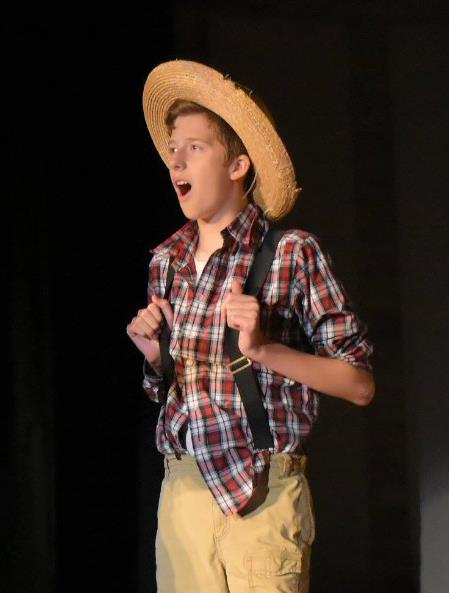

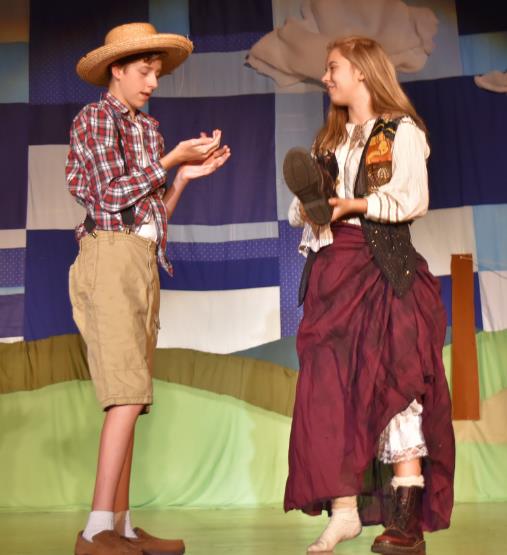
ArtReach's
Jack in the Beanstalk - Campanile Summer Youth Theatre,
Minocqua WI
Dreams of Magic:
Magic Polly tells Jack the magic beans will do all his chores and
grow candy canes. If you had magic beans what powers would you like
them to have?
Castle in the Sky:
What kind of castle do the giants live in? Is it beautiful and
ornate? Or run down and falling apart? What kind of furniture do you
think you would find there? Jack hid in a potato bin. What kind of
hiding places would you look for in a castle in the sky? Roll out
some paper on the floor and draw a picture of your classes' castle.